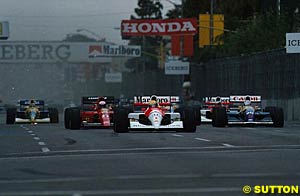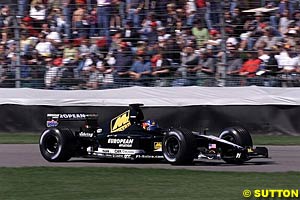
Atlas F1 Magazine Writer
What was special about Ayrton Senna's win at Phoenix 1991? Which tyre maker has the upper hand in Indy? And under what conditions will the World Championship be decided next Sunday? Marcel Schot brings the answers and more anecdotes on the fifteenth round of 2003
Looking forward to Indianapolis, history shows that Schumacher has a good chance to get a little closer to the one record he does not have yet. After scoring pole position in all three previous races at Indianapolis, his 56th Pole could well arrive in America, bringing the German just nine behind Ayrton Senna.
Ayrton Senna's pole position lap was over a second faster than that of his rival Alain Prost in the Ferrari. Normally this would have been just bad, but against an untested car it was downright humiliating.
On race day Senna left no room for misunderstanding - he took off from the start and never looked back. At a steady rate of 0.7 seconds per lap, the McLaren driver disappeared into the distance. When number two Alain Prost came in for his pitstop after 45 laps, Senna led by a comfortable 32 seconds. After that things were quickly made all the more easy for Senna: the Ferrari team messed up Prost's pitstop, dropping the Frenchman to seventh place and giving Williams driver Riccardo Patrese second place behind Senna.
Once Senna pitted, he rejoined the track some 16 seconds ahead of his followers. Just a lap later, Patrese's gearbox put an end to his race, giving Nelson Piquet second place. During the next ten laps, Senna increased his lead to 40 seconds with Alain Prost fighting back into second. With three laps to go, the leader decided to save his machine and slowed down considerably. When the flag dropped, 16 seconds separated the numbers one and two.
However, the 1991 US Grand Prix was a long time ago. Not one of the current drivers took part in that race. Michael Schumacher was about to appear in the Formula One scene later that season, while Fernando Alonso was just nine years old - perhaps watching the race on television, day-dreaming about driving such a fantastic car when he's grown up.
Just like in his first race at Indianapolis, Alonso drives this year's race on Michelin tyres. The difference of course is that in 2001 he drove for a team that was completing the field and now he's one of Michelin's key drivers. Much has been said about the tyre war, but so far it's a tie when we look at race wins. Both Michelin and Bridgestone took seven victories so far in 2003, so each one will be looking forward to beating the other in the last two races of the season.
Historically Bridgestone has the upper hand. They are as yet unbeaten at Indianapolis and they have their home Grand Prix in Japan as the season's finale coming up after this race. Michelin's last victory on American soil came in the 1984 Detroit Grand Prix, courtesy of Nelson Piquet in his Brabham BT53. If we look at the overall results for both makes, there's also little between them. Bridgestone took five more wins (77-72) and one more pole position (76-75), while Michelin set eight more fastest laps (79-71).
In theory both titles can be decided at Indianapolis. When Williams score a one-two and Ferrari scores less than four points, Sir Frank's team will have secured their first Constructors' Championship since 1997.
On the other hand, if Michael Schumacher wins and Juan Pablo Montoya scores less than three points and Kimi Raikkonen doesn't finish second, the German will win his sixth title. In fact, in the highly theoretical situation that Montoya ends up with no points and Raikkonen scores four or less at Indianapolis, a second place would be enough for Schumacher to bring home the Championship.
After an abysmal race in Hungary, Ferrari were back in shape for their home Grand Prix. With an impressive win by Michael Schumacher, the tifosi got exactly what they wanted and expected. For no matter how bad a season the team endured, the fans expect no less than a victory when they arrive at Monza. Schumacher delivered, and with that win also scored his 50th victory for Ferrari. Just how incredible this feat is, can be seen when we look at Alain Prost's number of career wins. The Frenchman won 51 races in his entire career - just one more than Schumacher did for one team, and in half the time.
 The legendary Brazilian was also the last one to win a US Grand Prix before it moved to Indianapolis. At the beginning of the 1991 season the streets of Phoenix, Arizona, hosted the US Grand Prix. Prior to the season, the McLaren team had not been able to test the new MP4-6 car, but full of confidence the team decided to field it at Phoenix nonetheless. And, once qualifying was completed, they had not only taken pole, but the also had completely demolished the competition.
The legendary Brazilian was also the last one to win a US Grand Prix before it moved to Indianapolis. At the beginning of the 1991 season the streets of Phoenix, Arizona, hosted the US Grand Prix. Prior to the season, the McLaren team had not been able to test the new MP4-6 car, but full of confidence the team decided to field it at Phoenix nonetheless. And, once qualifying was completed, they had not only taken pole, but the also had completely demolished the competition.
 Now Fernando Alonso is a Grand Prix winner, who went from the best race of his F1 life at Hungary to possibly one of the most difficult in Italy. His only previous US Grand Prix, in 2001 with Minardi, gave him the best grid position of his career until then: 17th. Unfortunately, his race ended at his first pitstop with a broken halfshaft.
Now Fernando Alonso is a Grand Prix winner, who went from the best race of his F1 life at Hungary to possibly one of the most difficult in Italy. His only previous US Grand Prix, in 2001 with Minardi, gave him the best grid position of his career until then: 17th. Unfortunately, his race ended at his first pitstop with a broken halfshaft.
|
Volume 9, Issue 39
Atlas F1 Exclusive
Giancarlo Fisichella: Through the Visor
Articles
The Enemy Within
Season in the Sun
2003 US GP Preview
2003 US GP Preview
US Facts & Stats
Columns
The Fuel Stop
Rear View Mirror
The F1 Trivia Quiz
Bookworm Critique
On the Road
Elsewhere in Racing
The Weekly Grapevine
> Homepage |